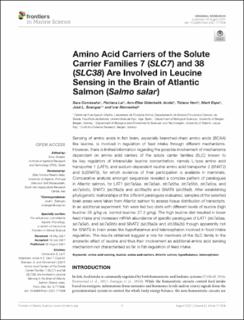| dc.contributor.author | Comesaña, Sara | |
| dc.contributor.author | Lai, Floriana | |
| dc.contributor.author | Jordal, Ann-Elise Olderbakk | |
| dc.contributor.author | Verri, Tiziano | |
| dc.contributor.author | Espe, Marit | |
| dc.contributor.author | Soengas, José L. | |
| dc.contributor.author | Rønnestad, Ivar | |
| dc.date.accessioned | 2021-10-25T11:15:41Z | |
| dc.date.available | 2021-10-25T11:15:41Z | |
| dc.date.created | 2021-10-20T16:33:34Z | |
| dc.date.issued | 2021 | |
| dc.identifier.issn | 2296-7745 | |
| dc.identifier.uri | https://hdl.handle.net/11250/2825318 | |
| dc.description.abstract | Sensing of amino acids in fish brain, especially branched-chain amino acids (BCAA) like leucine, is involved in regulation of feed intake through different mechanisms. However, there is limited information regarding the possible involvement of mechanisms dependent on amino acid carriers of the solute carrier families (SLC) known to be key regulators of intracellular leucine concentration, namely L-type amino acid transporter 1 (LAT1), and sodium-dependent neutral amino acid transporter 2 (SNAT2) and 9,(SNAT9), for which evidence of their participation is available in mammals. Comparative analysis amongst sequences revealed a complex pattern of paralogues in Atlantic salmon, for LAT1 (slc7a5aa, slc7a5ab, slc7a5ba, slc7a5bb, slc7a5ca, and slc7a5cb), SNAT2 (slc38a2a and slc38a2b) and SNAT9 (slc38a9). After establishing phylogenetic relationships of the different paralogues evaluated, samples of the selected brain areas were taken from Atlantic salmon to assess tissue distribution of transcripts. In an additional experiment, fish were fed two diets with different levels of leucine (high leucine: 35 g/kg vs. control leucine: 27.3 g/kg). The high leucine diet resulted in lower feed intake and increased mRNA abundance of specific paralogues of LAT1 (slc7a5aa, slc7a5ab, and slc7a5bb) and SNAT2 (slc38a2a and slc38a2b) though apparently not for SNAT9 in brain areas like hypothalamus and telencephalon involved in food intake regulation. The results obtained suggest a role for members of the SLC family in the anorectic effect of leucine and thus their involvement as additional amino acid sensing mechanism not characterised so far in fish regulation of feed intake. | en_US |
| dc.language.iso | eng | en_US |
| dc.publisher | Frontiers Media | en_US |
| dc.rights | Navngivelse 4.0 Internasjonal | * |
| dc.rights.uri | http://creativecommons.org/licenses/by/4.0/deed.no | * |
| dc.title | Amino Acid Carriers of the Solute Carrier Families 7 (SLC7) and 38 (SLC38) Are Involved in Leucine Sensing in the Brain of Atlantic Salmon (Salmo salar) | en_US |
| dc.type | Journal article | en_US |
| dc.type | Peer reviewed | en_US |
| dc.description.version | publishedVersion | en_US |
| dc.rights.holder | Copyright 2021 Comesaña, Lai, Olderbakk Jordal, Verri, Espe, Soengas and Rønnestad. | en_US |
| dc.source.articlenumber | 711508 | en_US |
| cristin.ispublished | true | |
| cristin.fulltext | original | |
| cristin.qualitycode | 1 | |
| dc.identifier.doi | 10.3389/fmars.2021.711508 | |
| dc.identifier.cristin | 1947392 | |
| dc.source.journal | Frontiers in Marine Science | en_US |
| dc.relation.project | Norges forskningsråd: 267626 | en_US |
| dc.identifier.citation | Frontiers in Marine Science. 2021, 8, 711508. | en_US |
| dc.source.volume | 8 | en_US |

